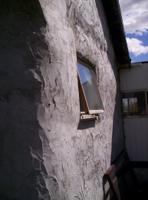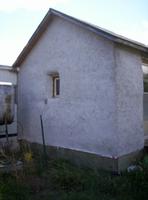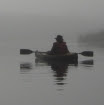There were times today, as I stared at the grasses where my sampling frame had fallen, when my work seemed ridiculously unimportant. I know there are always tragedies unfolding somewhere in the world, and some huge tragedies pass without our notice. Still, that knowledge does nothing to ease my mind about the devastation in New Orleans.
I've been reading a lot about it on the Internet. At first, people were just sharing what they knew of the events, and how to help. Then there was a shift to dismay and anger as the situation got worse instead of better. Today, perhaps because the relief efforts seem to be taking hold, people have begun to tackle the questions of why. Why did so many people stay? Why were there no buses to move those who couldn't drive? Why is the relief taking longer than we expect? Why? Why?
Some have suggested, in comments ranging from subtly patronizing to blatantly dismissive, that all this was just the natural consequence of building a major city below sea level. That seemed much too simplistic for me. I had to ask:
How did New Orleans get to be below sea level in the first place?
Was there really a decision some decades ago to pump out a hole and put buildings in it?
According to
Wikipedia, there was, but there were also other factors. When New Orleans was first established nearly 300 years ago, the site was chosen because it was
high ground. It was also a very important location, near the mouth of the Mississippi River which allowed water transport deep into the interior of the continent. Because of these natural advantages, New Orleans grew rapidly. It stretched out along the natural levees (raised banks) that bordered the river and its former channels. Behind the levees was swampy ground that flooded often, limiting the growth of the city. Finally, early in the twentieth century, the city began using pumps and canals to drain low swampy land for new construction, allowing great expansion. Obviously, this lower land was vulnerable right from the start. However, some other slow and subtle changes have made the situation worse.
No, I'm not talking about climate change.
One change is a complication of draining the low land. Constantly pumping out water has allowed formerly saturated soil to shrink and settle. Gradually, over the last century, the ground under New Orleans has sunk.
Another change is a partly natural process. When a river floods, leaving the confines of its channel, its flow is spread over a much larger area and therefore slows down. In slower water, silt settles to the bottom. Much of this silt ends up on top of the river bank, where the water first slows down. Over time, with repeated flooding, a ridge builds up along the bank. Then the river floods less frequently, so more of the silt is dropped inside the river channel, instead of out on the floodplain. Eventually, the entire river can be raised above the surrounding land. In fact, the term "levee" comes from a French word meaning "lifted."
Of course, once there are buildings on a floodplain, people want to protect them, so they build the levees even higher, and the river floods even less frequently. More silt builds up in the riverbed, and less gets added to the floodplain. Slowly, slowly, the water level moves even higher compared to the land.
These changes, happening over most of the last century, and to some extent over the last three centuries, have put the city lower with respect to surrounding waters.
Then there are changes to the coastal marshlands. When a storm surge driven by a hurricane comes onto the Louisiana coast, it loses much of its height and force in a huge area of marshes. However, these marshes have been disappearing since the 1930s, when the levees of the Mississippi were raised for greater flood protection. Silt from floods used to build up the marshlands, but now that silt goes straight out into deeper water in the Gulf of Mexico. At the same time, the marshes have been eroding faster than before, because of numerous canals cut through them for shipping and oil exploration. Almost 2000 square miles of marshes have vanished since the 30s, and the loss continues at a rate of "roughly one acre every 33 minutes"
(National Geographic, October 2004). If you start into the article I've linked, and the opening description of the hurricane's devastation seems slightly off, just notice when it was written.
Having read all this, I now realize that New Orleans wasn't always a disaster waiting to happen. Its vulnerability grew slowly over many decades. In the meantime it had already become a major port city, an important cultural centre, and a treasured place for hundreds of thousands, if not millions of people.
What happens now? How much of the city will be rebuilt? Can the artificial levees be built to withstand higher storm surges? What about the problems of subsidence, and silt deposition in the riverbed, and loss of coastal marshlands? What can be done to slow or reverse these changes? Or will they continue unabated? When the next major hurricane hits, will the devastation be even worse?
And why do I spend my time monitoring the regrowth of grass on old oil well sites?
 This new book is almost as beautiful as its subject: the Red Lily in Saskatchewan. It is a wonderful centennial-year tribute to our province's floral emblem, a treat to browse through just for the pictures, and a goldmine of knowledge. Authors Bonnie Lawrence and Anna Leighton share their findings from a ten-year study of the lives of lilies at three Saskatchewan sites, as well as their wisdom from many more years of keen observation of nature. We meet not only the lilies, but also many other creatures, from meadow voles to lily bulb thrips. Bonnie and Anna's creativity shines from the pages: even charts and graphs are works of art. Far from a dry scientific study, this book is rich with stories and recollections of the lily in prairie life reaching back through generations to the first days of settlement. In the back of the book you will find a section on growing the Red Lily in your garden, and even instructions for making paper lilies.
This new book is almost as beautiful as its subject: the Red Lily in Saskatchewan. It is a wonderful centennial-year tribute to our province's floral emblem, a treat to browse through just for the pictures, and a goldmine of knowledge. Authors Bonnie Lawrence and Anna Leighton share their findings from a ten-year study of the lives of lilies at three Saskatchewan sites, as well as their wisdom from many more years of keen observation of nature. We meet not only the lilies, but also many other creatures, from meadow voles to lily bulb thrips. Bonnie and Anna's creativity shines from the pages: even charts and graphs are works of art. Far from a dry scientific study, this book is rich with stories and recollections of the lily in prairie life reaching back through generations to the first days of settlement. In the back of the book you will find a section on growing the Red Lily in your garden, and even instructions for making paper lilies.











